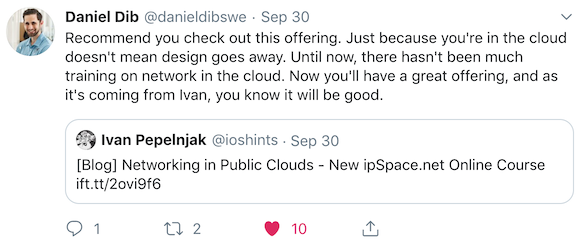Networking in Public Cloud Deployments
Networking in Public Cloud Deployments
This online course will give you all the knowledge (and confidence) you need to design networking solutions to support workload deployments in public clouds, connect your WAN to public clouds, and build robust hybrid cloud deployments.
It will also help you develop T-shaped skills - we’ll focus on networking but give you enough information about the adjacent technologies (storage, compute - including containers and serverless, network services and security...) to understand the challenges faced by professionals focused on those technologies, and to be able to fit networking seamlessly into the bigger picture.
Is This You?
- Network architect, technical pre-sales engineer, or similar senior, technical leader role
- Networking engineer supporting enterprise IT infrastructure
- Networking professional trying to stay ahead of the curve or improve your career prospects
- DevOps engineer or SRE managing network infrastructure in a public cloud deployment
Are You...
- Involved in designing, planning or deploying workloads in public clouds;
- Designing or planning connectivity between your data center and public cloud deployments;
- Connecting your company’s WAN network to applications running in public cloud;

- Adrian Giacometti, Sr. Network Architect and Automation Engineer
- Best career investment in a long time. I'm impressed with the quality, content, and structure. It feels like a university master's degree in networking suited for these times. Besides learning and practicing all specific topics of the course, you will learn about the surrounding technologies and how/why all fit together, which is for me the most valuable aspect.
Read more...
Do You Have These Challenges?
Trying to fix existing deployments?
- Your developers deployed their workloads to cloud and now you're left with the exercise of connecting those workloads to your enterprise infrastructure
- Your organization went into cloud and now you have to support connectivity towards cloud applications
- Your organization started deploying applications in a public cloud without any connectivity strategy, and now asked you to redesign the NAT-over-NAT-over-NAT-with-custom-static-routing mess someone else created
Still have a bit of time?
- You were asked to design or implement infrastructure needed for a public cloud deployment
- You don't want to make decisions based on biased information like vendor design guidelines;
- You have to design optimal solutions without knowing the capacity, flexibility or reliability requirements;
- You have to balance proven networking designs and architectures with the latest hyped-up technologies;
Trying to get fluent with public clouds?
- You're wondering whether enterprise technologies like workload mobility or stretched VLANs apply to public cloud deployments;
- Your CxO talks about DevOps and cloud deployments, and you're wondering what he really means, and how that might impact stability and security of your infrastructure.
- Have limited time in your schedule to stay up to date, separate truth from vendor hype, and evaluate the true impact of new technologies
- Want to avoid expensive solutions and untested technologies that benefit vendors more than the end-users
This ipSpace.net online course might be exactly what you need to move forward.
What Will You Get with this Course?
- Transparent and vendor-neutral approach, based on more than 25 years of design and deployment experiences;
- Focused on real-world problems and optimal solutions, not technologies and products promoted by individual vendors;
- Sample designs from public cloud deployments;
- Membership in a private community: stay in touch long after the course and expand your network;
- Group- and individual assignments: work together and solve tough problems;
- Certificate-of-completion document for your career documentation files.
Content created by leading industry experts
- Downloadable recordings of past guest speaker presentations with Q&A discussions;
- Access to webinars and other materials related to every course module;
- Reading lists and case studies;
- In-depth content for additional self-study.
We'll be there for you
- Sample solutions from Ivan Pepelnjak and guest speakers;
- Strong Slack-based community support from fellow engineers, Ivan Pepelnjak, and past guest speakers;
- Email support through 12 months from the registration (self-paced version of the course) or through the duration of Expert subscription.
- Jose Jara, Independent Network Engineer
- I found the course very useful for engineers that they want to learn cloud networking and for "CLI jockeys" to fill the gap between traditional and the latest relevant technologies.
Watch the course introduction video to learn more about the course. We have no plans for the next live course at the moment, but you can get a glimpse of how this course works when the live option is available.
We'll Talk About
Overview
- Overview of infrastructure cloud services
- Collecting the requirements
- Easy wins
- Transforming a traditional environment into a public cloud deployment
- Compute and storage elements
- How identity is super important in your approach to networking in the cloud
Networking in Public Clouds
- Cloud networking is different
- Building a virtual network and deploying network services
- What do you mean there is no layer-2?
- What do you mean I have to pay for all the traffic? How can I control the costs?
- Securing your public cloud deployment
- Connecting your on-premises workloads with public clouds using direct links, VPNs or SD-WAN
Putting It All Together
- Automating cloud deployments
- Infrastructure-as-Code and Immutable Infrastructure
- Building resilient architectures and preparing for disaster recovery
- Does multi-cloud makes sense or is it just a vendor ploy?
Heard Enough?
Unfortunately, it's impossible to get access to online courses at this time (more details). We apologize for the inconvenience.
At a Glance
- 10 modules
- Over 100 hours of self-study course materials
- Hands-on experience working on a solution to your own problem
- Design assignments
- Strong Slack-based support from your peers, Ivan Pepelnjak, and past guest speakers
- Final course completion certificate
Table of Contents
- Course Introduction 43:56
- Getting Started 8:13:33
- Automating Cloud Deployments 31:34:27
- Compute and Storage Infrastructure 6:10:46
- Networking in Public Clouds 10:31:53
- IPv6 in Public Cloud Deployments 5:00:35
- Security Considerations 10:43:46
- Network Services 7:17:37
- High-Availability Architectures 6:09:09
- Hybrid Clouds and Multi-Cloud 7:38:50
- Final Thoughts 7:26:48
- Webinars Included in Self-Study Materials 120:06:00
Course Outline
The course is structured in 10 modules:
- Course Introduction
- Getting Started
- Automating Cloud Deployments
- Compute and Storage Infrastructure
- Networking in Public Clouds
- IPv6 in Public Cloud Deployment
- Security Considerations
- Network Services
- High-Availability Architectures
- Hybrid Clouds and Multi-Cloud
For more details, explore the detailed course description.
Self-Study Materials and Hands-On Exercises
Each module contains hours of self-study materials; some of them include hands-on exercises. The hands-on exercises will help you get started on your cloud journey, or give you an outline of a solution that you might need in your environment.
The self-study materials include:
- Selected ipSpace.net webinars;
- Recordings of the past live course sessions;
- PDFs and books;
- Recommended podcasts and reading lists;
- Case studies and more.
For more details, explore the current self-study materials.
Our content management system will guide you through each module, and our mentor (Ivan Pepelnjak) will review and comment every hands-on exercise you'll submit.
Logistics Details
How much time will you need:
- The course is split into 10 modules which include recordings of guest speaker presentations (2-3 hours) and self-study materials (up to 10 hours per module).
- You might need up to 5 hours per week to study the materials, but as you get them when you register for the course you'll be able to study them over a longer period of time.
- Plan to spend an additional day or two per module on hands-on exercises;
- Don't be surprised if you'll need up to 6 months to complete all the course modules.
Past Guest Speakers sessions
Live sessions of this course included numerous guest speakers and extensive Q&A discussions. When joining this course, you'll be able to enjoy presentations from these experts:


 Cloud is changing many things for IT Ops and Infrastructure teams. While the cloud represents a whole new set of infrastructure technologies to learn, the biggest change is the reduced complexity and flexible cost models, allowing the consumption of infrastructure without dedicated Ops and Infra teams.
Cloud is changing many things for IT Ops and Infrastructure teams. While the cloud represents a whole new set of infrastructure technologies to learn, the biggest change is the reduced complexity and flexible cost models, allowing the consumption of infrastructure without dedicated Ops and Infra teams.
 A guiding principle of cloud technology is the ability to automate the deployment and configuration of infrastructure. In the second session of the course, Ned reviewed the principles of Infrastructure as Code (IaC) and how they apply to public cloud solutions. Then he took a look at the landscape of IaC tools that exist and examine their pros and cons. With a solid perspective on the toolsets, hel dived into a real-world application of deploying IaC using HashiCorp's Terraform.
Nedl started the session with a basic configuration and deploy it to Microsoft Azure. Then he added more components and import existing infrastructure into the configuration. With a base layer architecture, we can layer on additional deployments for applications and services. Finally, he automated the project's deployment through source control on GitHub and a CI/CD pipeline with Jenkins.
By the end of his presentation, you will have a basic understanding of Terraform and a firm idea of how to apply it to your environment with the principles of Infrastructure as Code.
A guiding principle of cloud technology is the ability to automate the deployment and configuration of infrastructure. In the second session of the course, Ned reviewed the principles of Infrastructure as Code (IaC) and how they apply to public cloud solutions. Then he took a look at the landscape of IaC tools that exist and examine their pros and cons. With a solid perspective on the toolsets, hel dived into a real-world application of deploying IaC using HashiCorp's Terraform.
Nedl started the session with a basic configuration and deploy it to Microsoft Azure. Then he added more components and import existing infrastructure into the configuration. With a base layer architecture, we can layer on additional deployments for applications and services. Finally, he automated the project's deployment through source control on GitHub and a CI/CD pipeline with Jenkins.
By the end of his presentation, you will have a basic understanding of Terraform and a firm idea of how to apply it to your environment with the principles of Infrastructure as Code.
 With the possible exception of scalability, storage presents many of the same challenges to public cloud users as to those running their data centers on-premises. Each has to choose from a plethora of options with very different performance, shareability, application, consistency, and data protection characteristics.
Hybrid clouds and organizations transitioning from on-premises to the public cloud face whole new classes of challenges driven by data gravity. Applications want to run close to the data, for lower latency, and data is expensive in both time and money to move from one place to another.
In this session with Howard Marks we reviewed the types of storage available across public clouds, how they differ between cloud providers, the applications and pitfalls associated with each. We looked at layering on storage abstractions with storage virtualization and distributed file systems. Our little tour ended with a look at cloud storage gateways, the connections between cloud storage and on-premises applications, and cloud solutions to other storage problems like global file systems.
With the possible exception of scalability, storage presents many of the same challenges to public cloud users as to those running their data centers on-premises. Each has to choose from a plethora of options with very different performance, shareability, application, consistency, and data protection characteristics.
Hybrid clouds and organizations transitioning from on-premises to the public cloud face whole new classes of challenges driven by data gravity. Applications want to run close to the data, for lower latency, and data is expensive in both time and money to move from one place to another.
In this session with Howard Marks we reviewed the types of storage available across public clouds, how they differ between cloud providers, the applications and pitfalls associated with each. We looked at layering on storage abstractions with storage virtualization and distributed file systems. Our little tour ended with a look at cloud storage gateways, the connections between cloud storage and on-premises applications, and cloud solutions to other storage problems like global file systems.
 In this session 'Matthias Luft recapitulated the Public Cloud Security groundwork detailed in
In this session 'Matthias Luft recapitulated the Public Cloud Security groundwork detailed in  Justin Warren explained how to make good tradeoffs between resilient hardware and resilient software.
He covered:
Justin Warren explained how to make good tradeoffs between resilient hardware and resilient software.
He covered: